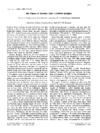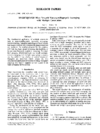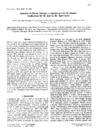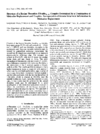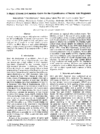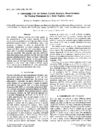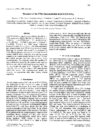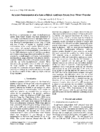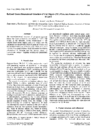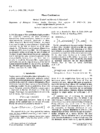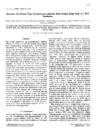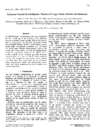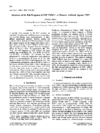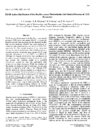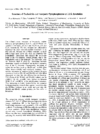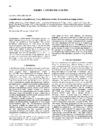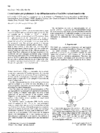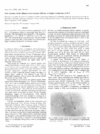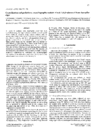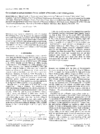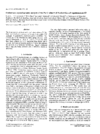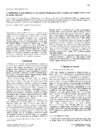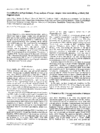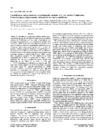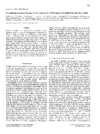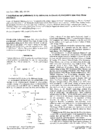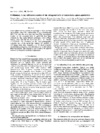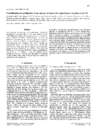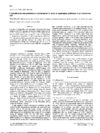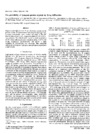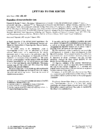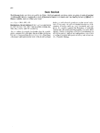issue contents
May 1996 issue

Cover illustration: NMR solution structure of an Antennapedia homeodomain complex with a 14-base pair operator DNA duplex. The dotted surface outlines a hydrated cavity in the protein-DNA interface.
international union of crystallography
Free 

research papers
Multiple domain and multiple space group non-crystallographic symmetry averaging have been incorporated into phase refinement and extension with simultaneous constraints. Example applications are described.
The structure of non-glycosylated human salivary amylase has been solved and refined to a resolution of 1.6 Å. The implications of this structure of amylase to its role in the oral cavity is discussed.
PDB reference: 1smd
Under certain conditions, the native Patterson map is shown to exhibit non-crystallographic symmetry away from the origin, which can be used to determine the translation components of local symmetry axes. This may be of use in searching for heavy-atom derivatives, non-crystallographic averaging and ab initio phasing methods.
One complex of thrombin-hirudin51−65 in the asymmetric unit was located by molecular replacement; the second complex was found by visual inspection of electron-density maps. Molecular replacement could locate the second complex only after the contribution of the first molecule had been subtracted from the structure factors by density modification.
PDB reference: 1vit
An economical and efficient matrix is presented for the crystallization of nucleic acid fragments, both DNA and RNA.
Four methods were employed in the structure solution of a small protein pheromone. A critical evaluation of each of the method's strengths and weaknesses in this case is presented.
PDB reference: 2erl
The DNA octanucleotide d(AGGTACGT)2 has been crystallized and its structure determined to 1.9 Å with molybdenum radiation. The modified A conformation shows both interstrand and intrastrand stacking.
PDB reference: 243d
The high-resolution structure of the winter flounder antifreeze protein has been determined. The molecular-replacement methods employed to solve this problematic structure may prove useful for solving other simple α-helical systems.
The structure of cat muscle pyruvate kinase. Conserved residues in interdomain and intersubunit contacts are implicated in allosteric regulation.
PDB reference: 1pkm
Two hen egg-white lysozyme tetragonal structures from crystals grown on earth and under microgravity have been refined at high resolution (1.33 and 1.40 Å, respectively). An Na+ atom was localized within the loop Ser60-Leu75. Comparisons with other lysozyme structures are described.
PDB reference: 193l
Rossmann and Blow as well as Hendrickson and Lattman had derived analytical expressions for the representation of phase probabilities, using different assumptions. It is shown that there is very little difference in the results.
The strucuture of a Kunitz-type α-chymotrypsin inhibitor, isolated from winged bean Psophocarpus tetragolobus seeds has been determined at 2.95 Å resolution. The protein structure is spherical and consists of 12 antiparallel β-strands, six of which form a β-barrel. The reactive-site loop is stabilized through hydrogen bonds.
An interferometer is used to measure refractive index changes as a diagnostic monitor, with time, of the concentration of salt and protein in solution during lysozyme crystal growth.
The crystal strucutre of an Fab fragement from a chimeric antibody was determined and compared to other immunoglogulins. The conformation of the CDR's and the effect of the chimerization are analysed.
PDB reference: 1mim
An active-site mutant of neural protease from B. cereus shows the importance of the Glu144 residue in the catalytic mechanism and suggests important roles for the bound water molecules in the active site.
PDB reference: 1esp
The refined structures of Escherichia coli inorganic pyrophosphatase allow a full description of the stabilization of the large active site, and detailed description of the results of site-directed mutagenesis.
short communications
This paper reports the successful crystallization of a plasminogen activator staphylokinase. The structure determination of staphylokinase wil provide provide considerable insight into the biochemical mechanism of the activation of plasminogen.
Crystallographic studies of the amyloidogenic Leu55Pro variant of transthyretin reveal a crystallographic packing different from the one presented by the wild-type protein, opening new perspectives for modelling the assembly of molecules in amyloid fibrils.
New crystals of the histone octamer, crytallized in 1.6 M KCl, 1.6 M phosphate, diffract to better than 2.65 Å, are in space group P61 or P65 and have lattice parameters a = b = 158.29, c = 103.27 Å.
The structure of endo-1,4-β-xylanase from Aspergillus niger has been solved by molecular replacement making use of the combined crystallographic information of four different crystal forms.
Crystals of brazzein, a small water-soluble sweet protein, have been grown by the vapor-diffusion method using sodium sulfate as a precipitant. Preliminary X-ray analysis gives space group I4122 and a = b = 61.4, c = 59.Å with one molecule in the asymmetric unit.
The ParE subunit of Escherichia coli topoisomerase IV has been crystallized in the presence of the non-hydrolyzable ATP analogue, 5'-adenyl-β,γ-imidodiphosphate (ADPNP).
Pig pancreatic α-amylase in complex with a proteinaceous inhibitor from the seeds of common bean Phaseolus vulgaris L. X-ray structure analysis of a mammalian α-amylase in complex with a bean lectin-like inhibitor.
An Fab fragment of a virus-neutralizing monoclonal antibody (DL11) that binds to herpes simplex virus glycoprotein D (HSV gD) has been purified, sequenced and crytallized. Diffraction data have been collected to 2.75 Å resolution.
Crystallization studies with the cell-wall synthesis enzyme MurB from Escherichia coli have produced two new crystal forms, one orthorhombic and one monoclinic, in addition to a tetragonal form described previously.
Spo0F a response regulatory protein involved in the sporulation signal tranduction has been crystallized. Preliminary diffraction data has been measured.
Hydroxynitrile lyase is a plant defence enzyme, which affords the release of HCN upon damage of a leaf. The cloned and overexpressed enzyme was crystallized from ammonium sulfate.
Native horse-spleen apoferritin has been crystallized in space group P4212, with six protomers in the asymmetric unit. Crystals diffract to beyond 3.0 Å.
Horse-spleen apoferritin has been successfully crystallized in the orthorhombic P21212 space group. Preliminary X-ray analysis at 2.4 Å resolution is reported.
Chicken-liver glutathione S-transferase CL3-3 was expressed in Escherichia coli. Five different crystal forms were obtained from the recombinant proteins by the vapor-diffusion method.
Crystals of E. coli asparagine synthetase have been obtained from 45% saturated ammonium sulfate solution at pH 7.5 using its Cys-free mutant. The crystals belong to space group P21 and a = 52.90 (4), b = 126.2 (2), c = 52.8 (1) Å, β = 105.3 (1)irc with one dimer in the asymmetric unit. Data sets up to 2.7 Å have been collected.
Pressures above 0.2 GPa induce amorphization of lysozyme protein tetragonal crystals, while the orthorhombic lysozyme polymorph is squeezed to 85.5% by volume at 1.0 GPa; a diamond-anvil cell, an image-plate detector and synchrotron radiation have been applied for these measurements of compressibilty.
letters to the editor
Free 

books received
Free 



 journal menu
journal menu









